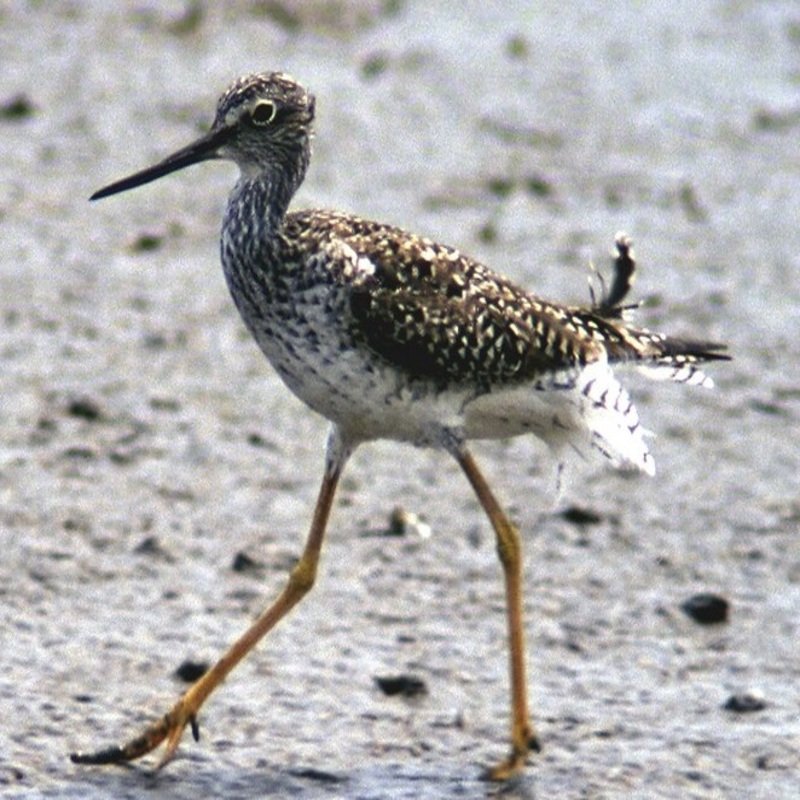Greater yellowlegs (Tringa melanoleuca) is a big shorebird found in North America. Tringa is the New Latin name given to the green sandpiper by Aldrovandus in 1599. It is derived from the Ancient Greek trungas, a wading bird the size of a thrush with a white rump and a tail that bobbles. The specific epithet melanoleuca derives from the Ancient Greek melas, meaning “black,” and leukos, meaning “white.”
Quick Overview: Tringa Melanoleuca – Greater Yellowlegs
Body size: Around 14 in (36 cm) and a weight of 235 g (8.28 oz)
Main colors: Brown, Black, White, Yellow
Range: Throughout the United States
Migratory Bird: Yes
Best time of the year to see in the U.S.: March, April, May, September, October, November
Conservation Status: Least Concern
Greater yellowlegs Description
The back of the greater yellowlegs is dark brown with lighter feather edges. Adults in alternative (breeding) plumage have black streaks on their heads, throats, and chests. Additionally, the bill is black. Their whitish flanks are black-barred and yellow feet.

Size
These birds have a length of 14 in (36 cm) and a weight of 235 g (8.28 oz). Their wings could range from 23-26 in (58-66 cm).
Feeding
The Greater Yellowlegs’ primary diet consists of small aquatic and terrestrial invertebrates, small fish, frogs, seeds, and berries. At times, Greater Yellowlegs would eat insects along the shoreline or seize them from the air.
Habitat
During migration and winter, the Greater Yellowlegs frequents a variety of wetland environments, from tidal flats to sewage ponds to flooded fields. Due to their bigger size, they are able to utilize wetlands with more mature flora than other shorebirds.
Behavior
Although Greater Yellowlegs are more solitary than most shorebirds, they migrate in flocks. It migrates between its subarctic breeding grounds and neotropical wintering habitats and is one of the first shorebirds to arrive in the spring. The migration pattern entails going a few hundred kilometers, resting, and then returning to the migration path. The migrating birds fly in small flocks at low altitudes and are often found alongside bigger flocks of warblers, various shorebirds, and herons.
Tringa Melanoleuca Scientific Classification
- Kingdom: Animalia
- Phylum: Chordata
- Subphylum: Chelicerata
- Class: Aves
- Order: Chordata
- Family: Scolopacidae
- Genus: Tringa
- Species: Tringa melanoleuca
Best time of the year to see
In the United States, the best time of year to see these birds are during the Spring season (March-May) and during the Autumn season (September – November).
Distribution of the Greater yellowlegs in the USA
Breeds throughout southern Alaska and Newfoundland. Winters primarily along the Pacific and Atlantic coasts, as well as throughout the southern states, along the Gulf coast, and into Mexico and the Caribbean.
The Greater yellowlegs can be found in the following states in the United States – Alabama, Alaska, Arizona, Arkansas, California, Colorado, Connecticut, Delaware, Florida, Georgia, Hawaii, Idaho, Illinois, Indiana, Iowa, Kansas, Kentucky, Louisiana, Maine, Maryland, Massachusetts, Michigan, Minnesota, Mississippi, Missouri, Montana, Nebraska, Nevada, New Hampshire, New Jersey, New Mexico, New York, North Carolina, North Dakota, Ohio, Oklahoma, Oregon, Pennsylvania, Rhode Island, South Carolina, South Dakota, Tennessee, Texas, Utah, Vermont, Virginia, Washington, West Virginia, Wisconsin, and Wyoming.
